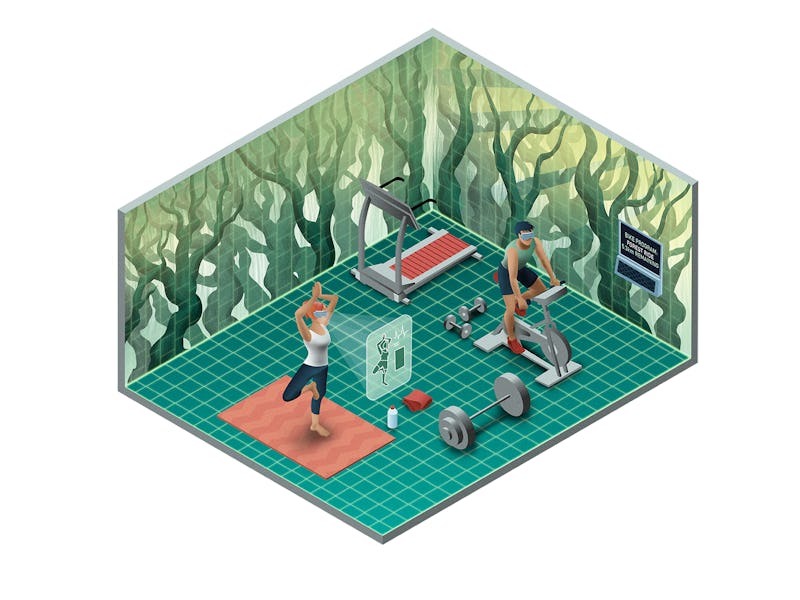"House of the Future" Shows How VR and Robots Will Transform Homes in 2050
Get ready for lots and lots of screens.

Ready to live in the house of the future? Elon Musk may have set the stage for the solar revolution with his sunlight-powered model home, but it’s small fries compared to what comes next.
A vision of the home in the year 2050, released by British broadband provider Plusnet last week, shows how future technologies can transform Musk’s original vision.
“Musk’s solar revolution looks after the health of our planet, integrating clean energy to power our cars and our homes,” Paul Goodison, digital transformation manager at Plusnet, tells Inverse. “Our home of the future builds on advancements in IoT tech to look after our personal health. Smart appliances, integrated health trackers and smart heating, each communicating with each other, combine to help us improve our diet, fitness and wellbeing.”
Enter the House of the Future
The outline covers five rooms of the house, mixing in a multitude of technologies including virtual reality, artificial intelligence, quantified self fitness tracking and more. Notably absent from the picture is a garage: with autonomous cars under development and expected to reach the general public in around three years’ time, the vision ditches the car’s traditional home in favor of a sharing economy where people call up rides when needed, akin to a supercharged version of Uber.
Musk’s original vision, outlined in October 2016 at the time of SolarCity’s proposed merger with Tesla, showed the house of the future to the press on the set of Desperate Housewives. A Tesla Model 3 electric car charges in the garage, a Tesla Solar Roof collects clean energy for the house, and a Powerwall stores solar energy for use during the night. With the Model 3 on the road and the Solar Roof shipping out to customers, here’s what the next 32 years could hold for technological advancements:
Kitchen
Kitchen of the future
The kitchen is focused on quantified self devices (think Apple Watch and Fitbit), taken to the next level with synchronized appliances recording occupants and suggesting meal ideas. It sounds a bit like the LG CLOi robot kitchen assistant that failed at the Consumer Electronics Show this year, but as communication advances and the wearables market doubles in size over the next three years, it’s not too unreasonable to think the kitchen of the future could plan out meals ahead of time.
As a robot dog similar to the Roomba cleans the floor, the windows collect solar power. It sounds outlandish, but Maryland-based SolarWindow has already developed the technology to harvest sunlight through the window.
Virtual Reality Wellness Room
Virtual Reality Wellness Room.
Virtual reality, in Plusnet’s vision, will be the center point of a room dedicated to fitness and meditation. The wearable headsets will transport users to far-flung worlds at the touch of a button.
“Humidity and temperature will be more accurately controlled, and small intelligent indoor gyms will be adapted to an individual, responding to the fitness and current state of motivation,” William Bird from Intelligent Health said in a statement. “However, technology that isolates people and keeps them indoors, away from green space, will have a negative effect on health so there will be indoor, climate-controlled plants so that gardens will be more indoors than outdoors, purely for the health benefits.”
Living Room
Living room of the future.
The living room of the future will be a lot cleaner than today’s home. David Tal from Quantumrun notes that “advancements in the material sciences” will produce furniture more resistant to scratches, stains and bacteria.
As for the TV? It’ll still be there, but Dan Trussler from Ancestral Health claims the future home will tend toward projectors instead of LCD panels to “limit the amount of unnatural light our eyes and skin are exposed to after sunset.”
Bathroom
Bathroom of the future.
Smart mirrors that suggest new hairstyles are all the rage in 2050, as are bio-electrical scales that can perform full body scans and provide comment on fitness goals.
“In the future, personal assistant technology will become more integrated with the structure of the house,” said Dayna Hairston, freelance interior designer. “We are starting to see this now with bathroom vanities with fully integrated technology features that show the news, weather, and traffic with a simple touch.”
Bedroom
Bedroom of the future.
The smart mirror from the bathroom makes an appearance in the bedroom as well. Virtual paintings and decorations could mean people switch out their surroundings in an instant. It sounds a bit like the screen-surrounded bedrooms of Black Mirror episode “Fifteen Million Merits,” but thankfully the scratch-resistant surfaces from the living room enable traditional decorations to mix with the virtual windows.